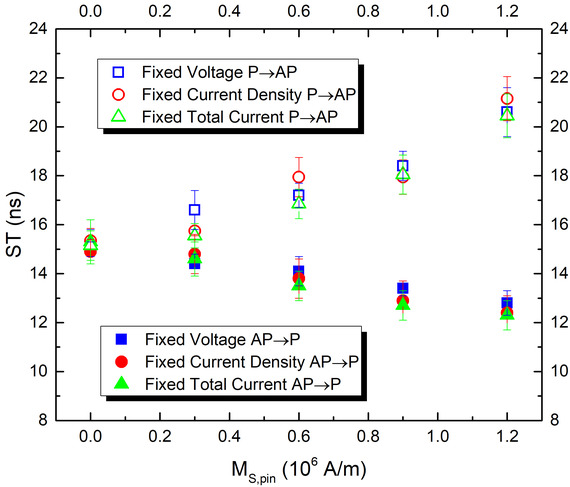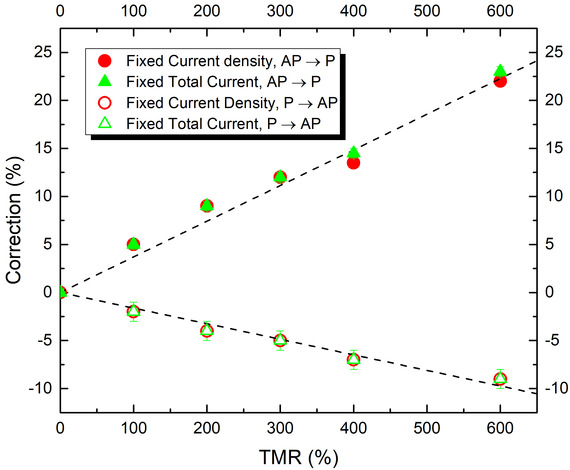 |
|
||||
BiographySimone Fiorentini was born 1992 in Verona, Italy. He received his Bachelor degree and Master Degree in Physiscs from the University of Padova, in 2014 and 2017, respectively. He carried out his Master Thesis the Ruprecht-Karls University of Heidelberg through the Erasmus Program. After a short period working for an IT company in Milan, Italy, he joined the Institute for Microelectronics in November 2018, where he started his PhD studies. He is currently investigating ways to appropriately simulate both spin and magnetization dynamics in non-volatile magnetic memory devices. |
|||||
Perpendicular STT-MRAM Switching at Fixed Voltage and Fixed Current
The outstanding improvement in the performance of modern integrated circuits has been supported by the continuous down-scaling of semiconductor devices. This has led to a substantial increase in leakages, however, which result in increasing stand-by power consumption. A viable path towards mitigating these issues is through the introduction of non-volatility into integrated circuits. Spin-transfer torque (STT) magnetoresistive random access memory (MRAM) is a promising candidate. It is competitive with conventional non-volatile flash memory as it combines high speed, excellent endurance and low cost. The core of an STT-MRAM device is a magnetic tunnel junction; the relative orientation of its magnetic layers provides a way of storing the binary information. Switching between the two possible configurations is achieved by passing an electric current through the structure. The electrons get spin-polarized by the reference layer, and when entering the free layer, they act via the exchange interaction on its magnetization providing a torque. With a sufficiently large current density, the magnetization of the free layer may be flipped.
The usual approach for micromagnetic simulations of STT switching is to assume a constant and uniform current density. In circuits and applications, however, the voltage, rather than the current density, is fixed during the switching process. The magnetization of the free layer is non-uniform during switching, which results in a position (and time) dependent current density. Moreover, as the tunneling resistance in a magnetic tunnel junction depends on the relative magnetization orientation of the two layers, the current density, J(r, t), depends on time. In order to evaluate the validity and limits of the fixed current density approach in computing the switching time, we have compared it with a model in which the total current is fixed but redistributed according to a position-dependent resistance determined by the local magnetization orientation. In addition, the fixed current and the fixed current density models are compared using a realistic approach in which the voltage during switching is kept constant. The switching time depends on the realization of the stochastic magnetic field, which mimics the fluctuations in magnetization at room temperature.
We have demonstrated that by slightly increasing the current from its initial value for AP to P switching and decreasing it for P to AP switching, the switching time distributions can be matched for any value of the stray field induced by the pinned layer (see Fig. 1). We then systematically studied the dependence of this current correction on system parameters. We observed that the value of the necessary correction increases with higher tunnel magnetoresistance (TMR) values at room temperature (Fig. 2), thus proving that the correction to the current is not universal and depends on the system parameters. To elaborate the physical origin of this dependence, we then performed macrospin simulations at zero temperature. We observed that the current correction is necessary in order to compensate for the different slope of the switching path between the fixed voltage and fixed current models (Fig. 3). This difference can be explained by the fact that in the model with fixed voltage, the dependence of the current on the magnetization configuration completely compensates the angular dependence in the torque, so the torque remains constant at switching. We also observed that faster switching always requires a higher value of correction. We have reproduced the switching times obtained within the realistic fixed voltage approach with the approximate fixed current density approach for a wide range of system parameters, provided that the dependence of the current correction on such parameters is taken into consideration.

Fig. 1: Comparison of switching times for the tuned values of input currents at T = 300 K. The switching times of all three models are compatible within thermal variation.

Fig. 2: The correction to the current that must be introduced in order for all three models to give similarly consistent results, as a function of TMR at T = 300 K, for both P → AP and AP → P switching. The dashed lines represent a linear fit.

Fig. 3: Switching realizations in the macrospin case for the fixed voltage and fixed current density models, with different values of correction.


